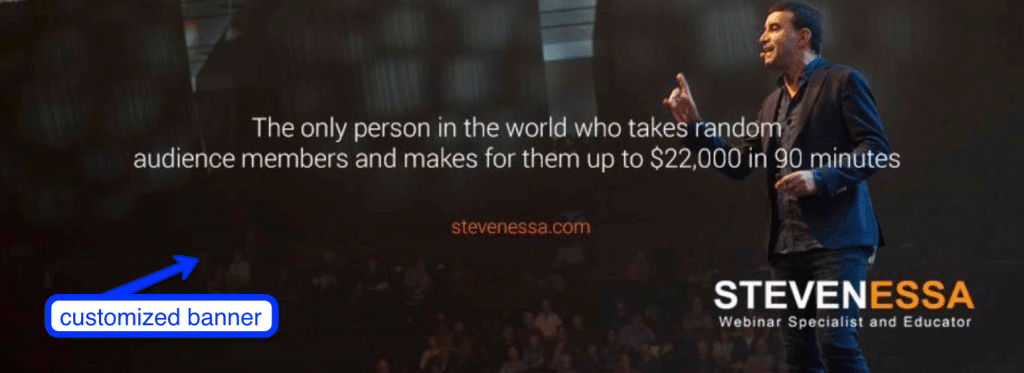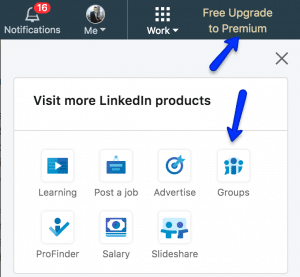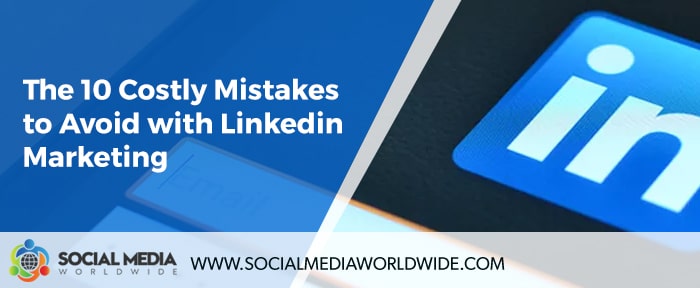Although using Linkedin for marketing is a fantastic way for business owners to grow their network, generate traffic and leads and build a solid reputation in their industry, there are many Linkedin marketing mistakes to avoid if you want to experience real results.
Mistake 1
The first Linkedin marketing mistake to avoid which is probably among the most costly ones is not optimizing your Linkedin account. On Linkedin, your profile has a profile strength, from beginner, to intermediate to “all star”. Ideally, your account should be “all star” which means it is optimized and managed correctly.
Therefore, make sure you have a professional looking profile picture that is square, 250 x 250 pixels. Make sure you also have a customised banner, an attention-grabbing headline, and the summary, experience, recommendations, and skills sections are filled in detail.

Mistake 2
The second Linkedin marketing mistake to avoid is not managing your Linkedin presence daily.
You should login every day and publish an update, accept and send Linkedin connection requests, engage with other people to nurture relationships, respond to personal messages (also known as inmail), and keep an eye on your Linkedin advertising if you are running any paid campaigns.

Managing your Linkedin presence daily is a sure-fire way to manage your reputation too, and address both positive and negative interactions.
Mistake 3
The third mistake to avoid when using Linkedin for marketing is incongruence. In other words, publishing content that is irrelevant to your audience and that doesn’t add value to them.
For example should you be in the life coaching business, publishing posts on self-development and self-esteem would be relevant, but publishing content on golf would be considered irrelevant.
This is why it’s very important to keep on topic or else you will quickly lose the interest of your audience, and experience a decline in audience size or audience engagement.
Mistake 4
The fourth mistake to avoid when using Linkedin for marketing is over-promoting. When you use Linkedin mainly as a platform to promote your business and service instead of using it to strengthen relationships and network, you can quickly lose the respect of your audience.
Instead, follow the 80-20 rule where 80% of your updates provide value and interesting insights for your audience and 20% of your posts promote your business. When you follow the 80-20 rule, you’ll notice that your promotional posts will have more impact as you will have earned the respect of your audience.
Mistake 5
The fifth mistake to avoid when using Linkedin for marketing is being too informal. Unlike other social networks like Instagram and Facebook which are more informal, as people use them to connect with friends and family, Linkedin is a professional social network.
In other words, people go on Linkedin to perform work and business related tasks. This is why it’s important when using Linkedin for business to not come across as too informal by publishing selfies for example or using slang. Instead, make sure you always come across as professional.
Mistake 6
The sixth mistake to avoid when using Linkedin for business marketing is not humanizing your brand. In other words, not giving an opportunity to your audience to get to know you professionally as well as personally.

This is why it’s important to also share updates, news and pictures of you, your clients and your team to humanize your brand. The more people get to know who you are as a person instead of just a business, the more responsive they’ll be when you market your products and services.
For example, should you be an interior designer, you could publish a picture of you and a client of yours in their newly-designed house.
Mistake 7
The seventh mistake to avoid when using Linkedin for business marketing is not leveraging all the Linkedin tools available. Tools include Linkedin Premium, which is the paid version of Linkedin which allows you for a monthly fee, to do things free accounts can’t.

For example, with a Premium account, you can send inmail messages (which are private messages on Linkedin) to people you are not connected to. You can cancel LinkedIn premium anytime you want later in the future.
Other tools include Linkedin advertising which allows you to market your business to anyone on Linkedin regardless of your Linkedin advertising budget as it’s a self-serve advertising platform.
Another useful tool on Linkedin is Linkedin groups which allow you to create your own community of people around a specific interest or join Linkedin groups and tap into specific audiences.
You can also use this email-finding tool browser extension that helps you find email addresses and phone numbers of anyone on LinkedIn in seconds here.
Mistake 8
The eighth mistake to avoid when using Linkedin for business marketing is not asking for recommendations. Linkedin allows you to display people’s recommendations, which is the equivalent of testimonials. The more recommendations you have the more social proof you have and the easier it will be to generate leads and referrals.
Don’t limit yourself to having 2 or 3 recommendations. Instead aim for over 50 recommendations and you can easily achieve this by sending personal requests to people you know by clicking on “ask to be recommended”.

You’ll also receive recommendations when you pay it forward and recommend other people. When you recommend other people, they will very likely return the favour by recommending you.
Mistake 9
The ninth mistake to avoid when using Linkedin for business is not putting together and executing a well thought a Linkedin marketing strategy. Most people join Linkedin without a clear end goal and specific timeframe to achieve it.
This is why when joining Linkedin, have clear goals in mind and put together a Linkedin marketing strategy that outlines the steps you need to take to achieve your goal. For example, your goal could be to build a network of 5,000 Linkedin connections within 12 weeks.
If so, your strategic plan should include all the daily tasks that need to be completed for 12 weeks in order to achieve that goal, such as sending 30 connections requests a day, accepting all connection requests daily, inviting all your email contacts to join you on Linkedin and adding a Linkedin profile link on your newsletter.
Mistake 10
The tenth mistake to avoid when using Linkedin for business is not tracking your efforts. When you don’t track your efforts you won’t know where to double your efforts and where to cut the cord.
For every goal you set you should have key performance indicators so you can track how close or how far you are from completing your target. For example, should your goal be to build an audience, your key performance indicator would be the number of connections you have. If your goal is to increase engagement, your key performance indicator would be the number of likes, shares and comments your posts receive.

There are many tools currently available such as Linkedin itself which provides information on audience growth and engagement rate but there are other tracking tools available depending on what you are trying to track.
For example, should you be tracking your Linkedin traffic, tools such as clickmeter.com help you measure exactly that.
About the Author

Corinna Essa is known internationally as the go-to person when it comes to social media marketing.
Corinna owns a social media marketing company helping businesses around the world leverage the power of social media without doing any of the legwork. Her company has been featured in many media outlets including Sky Business news, Working Women magazine, Ymagazine, Tasmanian Times, Channel 7 and 101fm.
Corinna is also the author of 2 bestselling books “Money On Demand – The 16 Fastest Ways to Becoming a Millionaire Online” and “Reach: The SECRETS to converting your social media audience into your network marketing downline fast”




Recent Comments